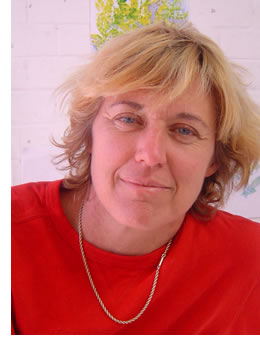|
Back to Index
Accidental
artist - Interview with Clare Douie
Upenyu
Makoni-Muchemwa, Kubatana.net
May 24, 2010
Read
Inside / Out with Clare Douie
 Artist
Clare Douie has built an international reputation as a book and
magazine illustrator. Her current subjects are the birds of Zimbabwe.
She is a music and art teacher at a girl's high school in
Harare. She recently opened her first exhibition in Zimbabwe. Artist
Clare Douie has built an international reputation as a book and
magazine illustrator. Her current subjects are the birds of Zimbabwe.
She is a music and art teacher at a girl's high school in
Harare. She recently opened her first exhibition in Zimbabwe.
What
medium do you work in?
Primarily I work in watercolours. I like the immediacy of the medium
and the fact that you get one shot and you have to get it right.
It's a lot of adrenalin, I find, working in watercolours.
How
did you become an artist?
Completely by accident. I'm trained as a scientist; I'm
a fresh water biologist. I worked as that for sometime. I'd
always wanted to do art, but when I was growing up nobody made a
living from that. So I had to do something sensible, so I did science,
but actually I paid for the science by doing art. I was illustrating
books and magazines from very early on at University.
Would
you say your background in science has influenced the way you paint?
I think profoundly. Whatever anybody does in their background affects
the way they look at life. It's all quite subjective.
Can
you describe your process?
If I'm composing a picture, I'll spend a lot of time
out in the field drawing. I won't work from photographs. I
spend a lot of time getting to know and understand the bird that
I'm working on. And then I do a lot of quick sketches that
pick up what that bird is about, the way it stands, the way it feeds,
who it is. I do a lot of those until I've really got a grip
on where it's at. The whole time I'm lying on the forest
floor trying to look underneath it. I spend a lot of time studying
everything around it and I'm trying to understand it and its
environment. When I started painting I did what a lot of bird artists
do, which is to paint a bird on a stick. It's really not saying
anything about who that bird is, it doesn't tell you anything.
For me it has to be part of the environment in which it's
in and because it's a more literal and less impressionistic
it's a direct translation of hauling the best things out of
the environment as well as the essence of the bird.
What
draws you to a particular subject?
I don't like to paint what everybody else paints. I don't
have a terrible urge to paint a fish eagle, because everybody wants
a fish eagle painted. But Zimbabwe is so much more than fish eagles.
I would love fish eagles far more if it weren't the only bird
that people talked about. We have the most extraordinary, beautiful,
cryptically coloured small birds with the most extraordinary natures.
Why
have you not exhibited locally?
I never meant to become an artist. I became an artist accidentally.
I signed a contract that made sure that I did nothing but illustrate
books for a long, long time. I think I had all this work somewhere
and I could live a different life and not have to talk about it.
I always thought that I'd go back into science at some stage,
but I never got through the commissioned work, and I never got through
what I had to do by which time I had so much work in other countries
that fellow Zimbabweans began to say "why don't you
do something here?" It seems a bit unpatriotic not to do something
here so there you go.
What
are your feelings on the importance of art?
Its profoundly important from a very visceral level, every child
from the second they have a chance wants to scribble on something.
Our ancestors have painted on cave walls. There's so much
more to us that should come out in some sort of artistic expression.
Do you
have any tips to share with aspiring artists?
Learn to draw before you do anything. Get yourself a sketchbook,
and every day draw a three-minute sketch of anything. Just draw
for three minutes and stop exactly after three minutes. Because
after three minutes you don't really mind what it looks like,
you have no expectations. Do that for a couple of months and then
go back and look at the first ones. You will be surprised at the
improvement.
Visit the Kubatana.net
fact
sheet
Please credit www.kubatana.net if you make use of material from this website.
This work is licensed under a Creative Commons License unless stated otherwise.
TOP
|

